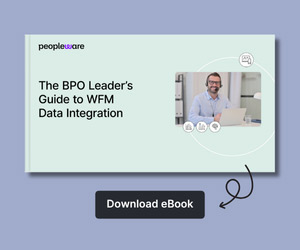Building on a previous article, ‘Why you need to reconsider voice in the contact centre’, Rafael Cortes, Head of Marketing at Foehn, explains why voice should be central to your Customer Experience (CX) strategy.
For many of us, nothing impacts business performance more than the cloud contact centre. Its power to increase sales, improve profitability and enhance brand values is irresistible and, not surprisingly, businesses everywhere are installing, replacing or renewing their contact centre systems.
Strategy is imperative but, faced with a chocolate box of features and communications channels, many businesses can be tempted to dive in at the deep end and lose sight of customer experience priorities. Amongst those priorities, one stands head and shoulders above the others – voice.
People Like Voice
Of course, omnichannel communication is key to a frictionless customer journey, but surveys show consistently that customers rate a voice conversation as their preferred channel of communication.
For example, recent research by Genesys, omnichannel’s leading exponent, estimates that 75% of consumers still believe humans provide the most effective customer service.
Why so? Some reasons are more obvious than others. For example, we’ve all experienced how a skilled agent has the power to convey tone, warmth and likability in a way that can enhance the customer experience far beyond the capabilities of digital alternatives.
Many consumers also believe voice delivers a faster and more confidential solution to their problem compared with webchat and text.
Agents Like Voice
Equally, it’s important to consider that the contact centre agent likes voice too. Compared with other digital channels, it requires less training, it’s simpler to use, easier to adopt and, perhaps most importantly, it’s the only channel that can be trusted for dealing with high-value or high-sensitivity calls.
For all contact centres, voice is a common denominator providing the foundations on which additional layers of communication can be built. That’s why voice should be the starting point for creating your contact centre strategy.
In practice, that’s not always the case. Today, too many customers still interact with frustrating, outdated virtual assistant technology and poor voice recognition software that put customer experience and brand loyalty at risk. The need to implement voice correctly, whether virtual or human, is central to any contact centre strategy.
With voice, there’s no half measures. Get it wrong and customers will leave you. Get it right and they will stay with you forever.
Where’s Voice Going?
To make voice work at its best, the agent needs control, agility and easy access to information before, during and after the call. Skills-based routing helps by allocating calls to the agents best qualified to handle specific customer issues.
Improved voice recognition means customers can respond to IVR questions with natural language, rather than the mind-numbing, repetitious series of one-word answers typical of older systems.
The latest voice analytics goes further, recognizing sentences and analysing the caller’s tone, vocabulary and mood to establish emotion and satisfaction levels.
Combined with predictive analytics, systems can identify when a caller is angry, when they are lying or even when they are trying to commit fraud.
These insights help agents to handle calls in the best way and allow contact centre managers to monitor customer–agent interactions, ensuring that any scripts are being followed and that conversations meet regulatory compliance.
Voice vs Chat
Originally a crude, cheap text communication for busy techies working on support desks, webchat has evolved into a mainstream channel. Thanks to machine learning, this simple tool is now famous for its ‘bot’ mode that can automate all or part of chat conversation.
Wide-scale adoption of webchat by productivity-hungry businesses has been driven by the belief that it provides a cheaper, quicker customer experience compared with voice.
On the contrary, examples of good and bad customer experience abound and the role of webchat versus voice calls has become a central argument in contact centre strategy for many businesses.
The trade-off between voice calls and webchat is different for every business, but here’s a consensus of opinion:
Phone Calls Are Cheaper Than Live Chat
On average, agents can successfully manage a maximum of two live chats. With three chats, productivity plummets. That’s because switching between chats means the agent is having to re-engage with a previous conversation, picking up an earlier train of thought and taking time in the process. Hence, calls are typically half the length of a live chat session and, correspondingly, cost less.
Customer Experience Is Driven by Emotion, Not a Text Message
Brand values are built on the type of emotional connection that a good contact centre agent can create. Chat lacks this capability.
Furthermore, customers on chat are aware that they are one of several being handled by a multi-tasking agent. Whereas a phone call is one-to-one, chat is one to many, leaving the customer feeling less special.
Chat Duration Is Unpredictable and Counter-Productive
On the customer side, chat sessions are often prolonged by interruptions and a perception that the agent will be available to answer indefinitely.
The extended handling time exacerbates the challenges faced by the agent in juggling multiple conversations and maintaining continuity of thought.
Multi-tasking Doesn’t Motivate
Agents faced with multiple concurrent chat sessions lose a sense of ownership and conscientiousness that doesn’t happen in a phone call.
Dealing with a sensitive subject on webchat is, intuitively, counter-productive to the job satisfaction and motivation of the agent. The impact on simple, transactional dialogues is less important.
Only 12.5% of Respondents Hate Bots
A survey by Genesys has established that, as usual, voice is by far the preferred contact centre channel and most customers would prefer to deal with a human.
Equally, only 12.5% of respondents didn’t want to use a chatbot. It seems that having the choice to use chat, as and when suits, is more important that the medium itself.
When chat suits, it’s fine. Given the choice, though, voice always wins.
There’s a lot more to voice, so look out for further articles coming up in the future.
In the meantime, Foehn’s latest white paper, ‘Cloud contact centre success strategies 2019’ will give you the bigger picture.
Author: Robyn Coppell
Published On: 24th Jun 2019 - Last modified: 26th Jun 2019
Read more about - Guest Blogs, Foehn



































